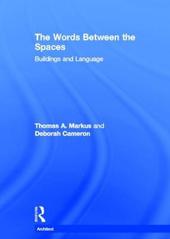
|
The Words between the Spaces: Buildings and Language
Hardback
Main Details
| Title |
The Words between the Spaces: Buildings and Language
|
| Authors and Contributors |
By (author) Thomas A. Markus
|
|
By (author) Deborah Cameron
|
| Series | Architext |
|---|
| Physical Properties |
| Format:Hardback | | Pages:208 | | Dimensions(mm): Height 246,Width 174 |
|
| Category/Genre | Theory of architecture |
|---|
| ISBN/Barcode |
9780415143455
|
| Classifications | Dewey:720.14 |
|---|
| Audience | | General | | Undergraduate | | Postgraduate, Research & Scholarly | | Professional & Vocational | |
|---|
| Illustrations |
15 line drawings, 10 b&w photographs
|
|
Publishing Details |
| Publisher |
Taylor & Francis Ltd
|
| Imprint |
Routledge
|
| Publication Date |
25 October 2001 |
| Publication Country |
United Kingdom
|
Description
Using language - speaking and understanding it - is a defining ability of human beings, woven into all human activity. It is therefore inevitable that it should be deeply implicated in the design, production and use of buildings. Building legislation, design guides, competition and other briefs, architectural criticism, teaching and scholarly material, and the media all produce their characteristic texts. When these prescribe what is to be built then, in a sense, they can be said to 'design' the eventual building. When they describe what is already built they are formative of our judgement and responses. The authors, one a linguist, the other an architect and historian, examine how such texts relate to issues of national identity, power structures, the creation of heritage, and the evaluation of projects by professional and lay critics. The role of images in these texts is crucial and is discussed in detail. The authors use texts about such projects as Berlin's new Reichstag, Scotland's new Parliament, and the Auschwitz concentration camp museum to clarify the interaction between texts, design, critical debate and response. Texts such as Prince Charles's 'A vision of Britain' and the 1919 Tudor Walters report on 'Housing for the Working Classes' had a wide influence on thinking, debate and, ultimately, on what was built and what was left unbuilt. Through a close reading of these and other texts the authors examine how the underlying ideological forces worked through language. Finally they discuss how questions about language and texts might influence both the teaching and the practice of architecture.
Reviews'Markus and Cameron continually provide a degree of examination, and wealth of detail and interpretation, that can only come from careful scholarly endeavour. It is succinct and to the point.' - The Architects' Journal
|